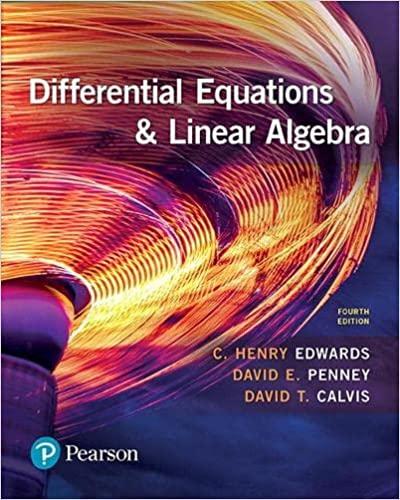Question:
Problems 20 through 23 deal with the same system of three railway cars (same masses) and two buffer springs (same spring constants) as shown in Fig. 7.5.6 and discussed in Example 2. The cars engage at time t = 0 with x1(0) = x2 (0) = x3 (0) = 0 and with the given initial velocities (where v0 = 48 ft/s). Show that the railway cars remain engaged until t = π/2 (s), after which time they proceed in their respective ways with constant velocities. Determine the values of these constant final velocities x'1 (t), x'2 (t), and x'3 (t) of the three cars for t > π/2. In each problem you should find (as in Example 2) that the first and third railway cars exchange behaviors in some appropriate sense.


Transcribed Image Text:
Example 2
k₂
kz
m₁ www.com m₂ www m3
ooooooo
00000000
00:00 0000
FIGURE 7.5.6. The three railway
cars of Example 2.
Railway cars Figure 7.5.6 shows three railway cars connected by buffer springs that react
when compressed, but disengage instead of stretching. With n = 3, k2 = k3 = k, and
k₁ k4= 0 in Eqs. (2) through (4), we get the system
which is equivalent to
with
-k k
[-]-[40]
= k -2k
m3
m1
m2
and
X" =
corresponding to the natural frequencies
@₁ = 0,
C₁ =
-C1
C2
0
λ₁ = 0, λ2 = -c1,
C₁ =
Hence the coefficient matrix A is
k
mi
If we assume further that m₁ = m3, so that c₁ = C3, then a brief computation gives
-λ(a + c)(a + c₁ +20₂) = 0
(20)
for the characteristic equation of the coefficient matrix A in Eq. (18). Hence the matrix A has
eigenvalues
C1
-202
C3
@2 = √√C₁,
m₁ = m3 = 750,
3000
750
A =
= 4,
(i = 1, 2, 3).
-4
6
0
0
C2
-C3
k -k
C₂ =
A3-C1-2c2
of the physical system.
For a numerical example, suppose that the first and third railway cars weigh 12 tons
each, that the middle car weighs 8 tons, and that the spring constant is k = 1.5 tons/ft; i.e.,
k = 3000 lb/ft. Then, using fps units with mass measured in slugs (a weight of 32 pounds
has a mass of 1 slug), we have
X
W3 = √c1 +2c₂2
m₂ = 500.
4 0
-12 6
4 -4
k
3000
500
.
X,
= 6.
(17)
(18)
(19)
(21a)
(21b)
(22)
and the eigenvalue-frequency pairs given by (21a) and (21b) are λ₁ = 0, ₁ = 0; λ₂ = -4,
w2 = 2; and λ3 = -16, 03 = 4.

![]()






